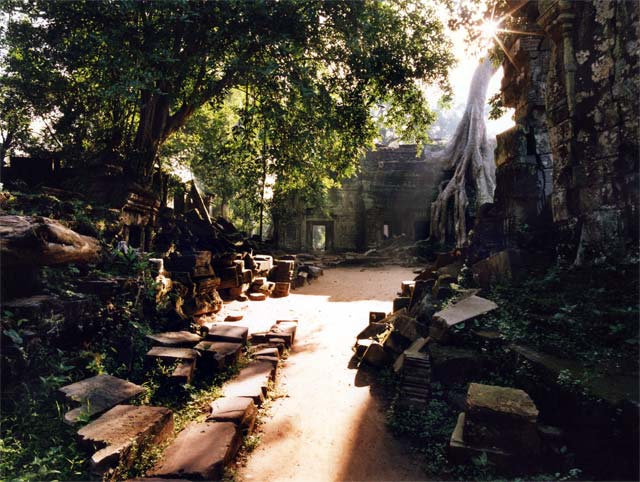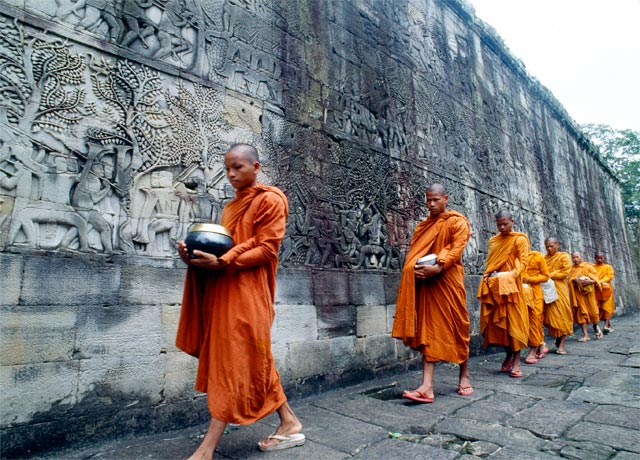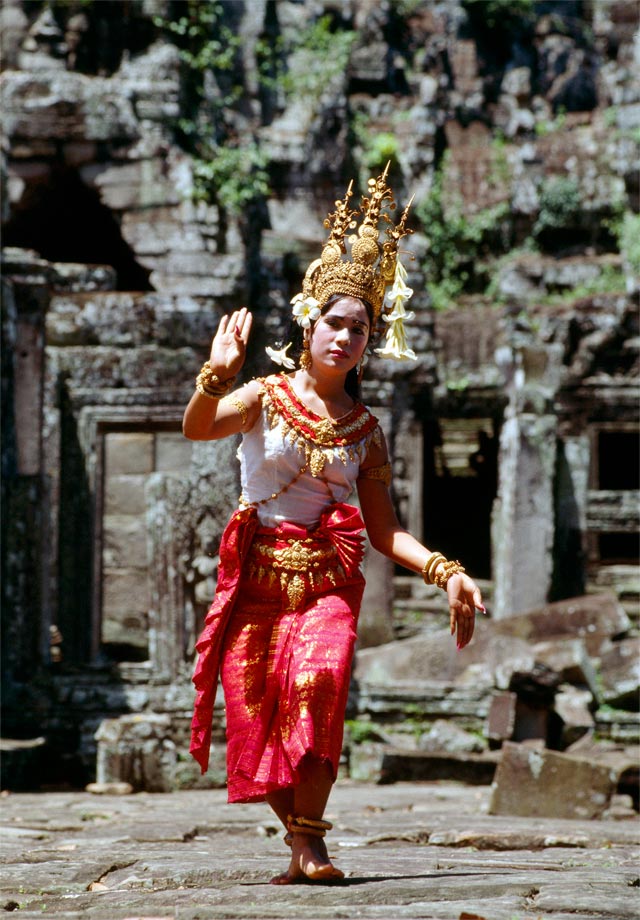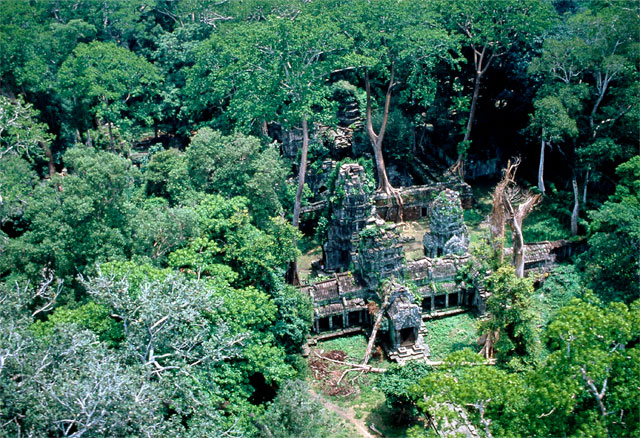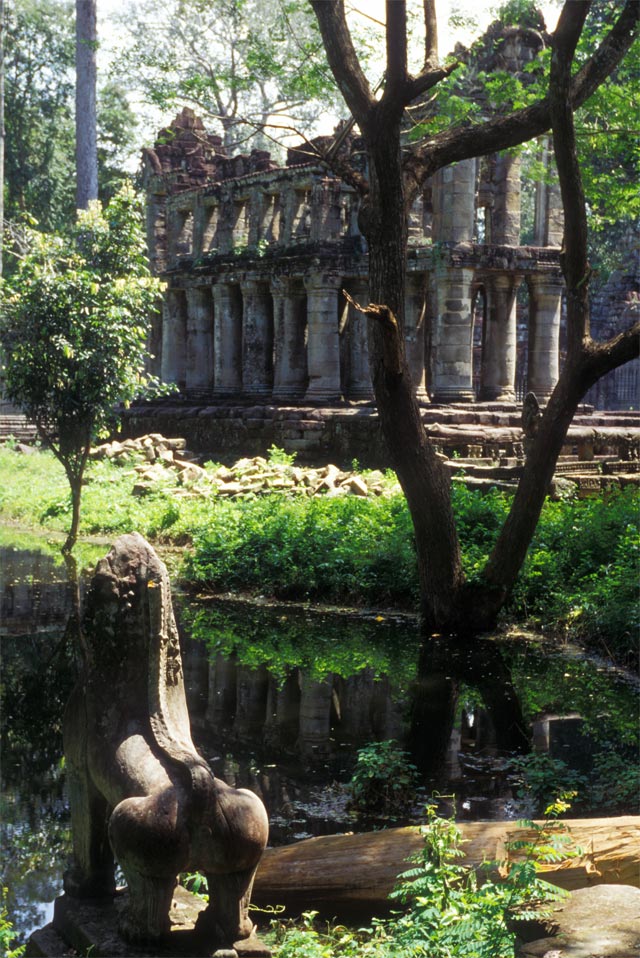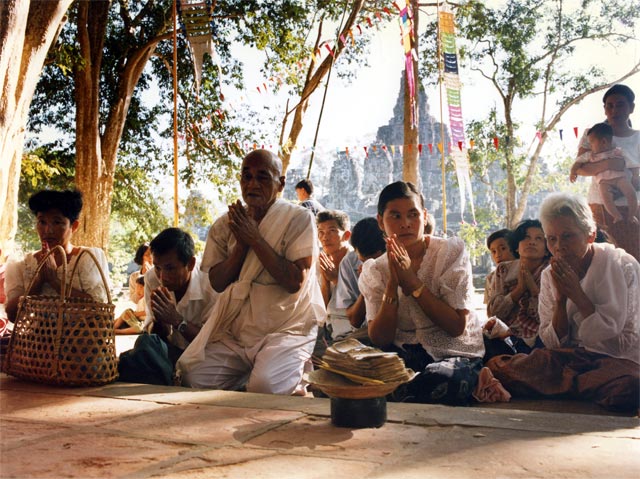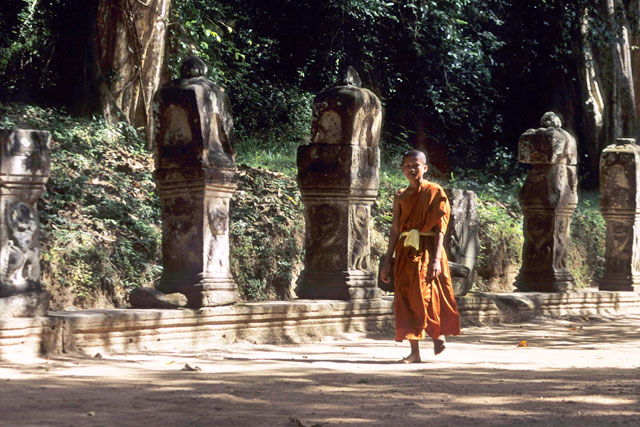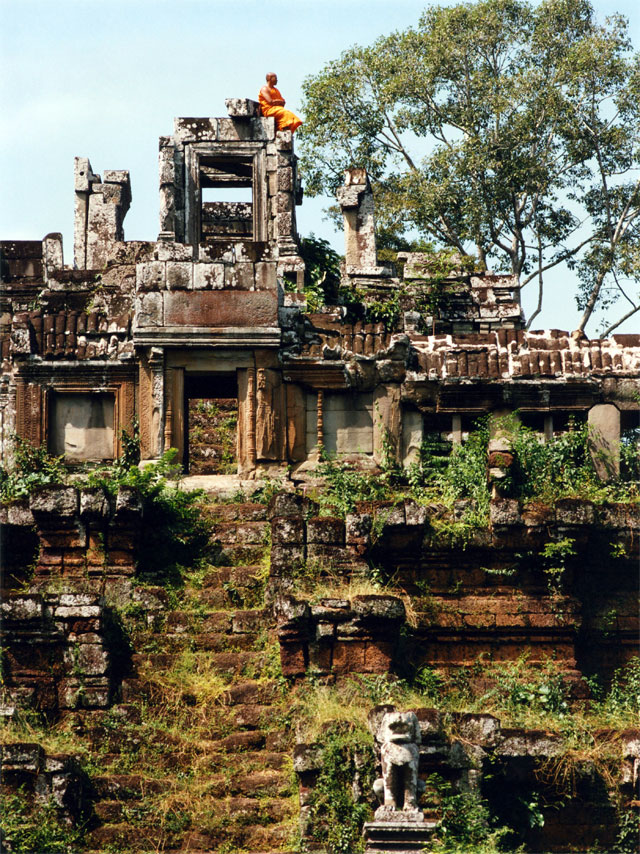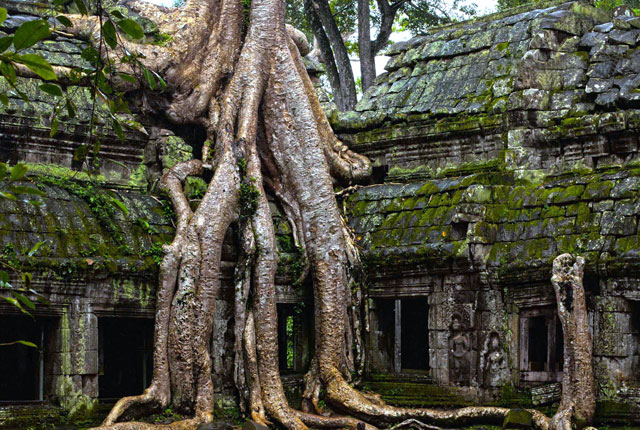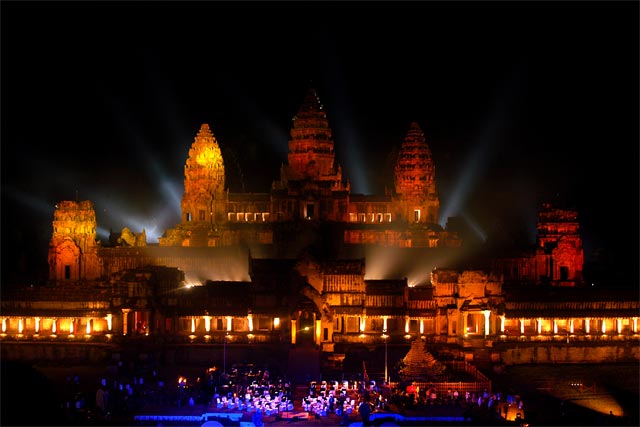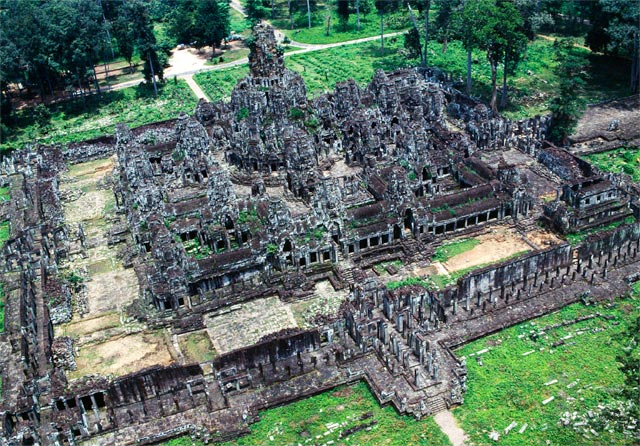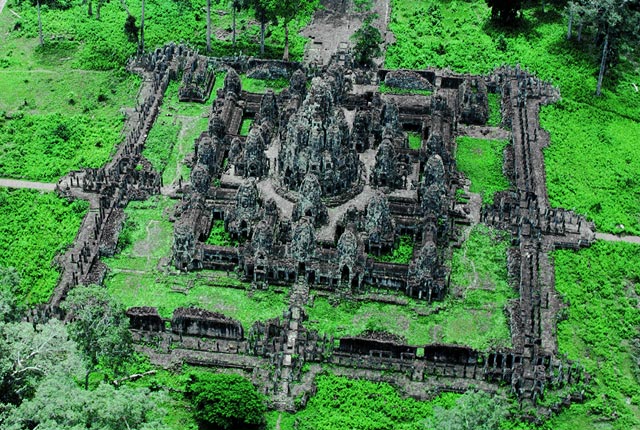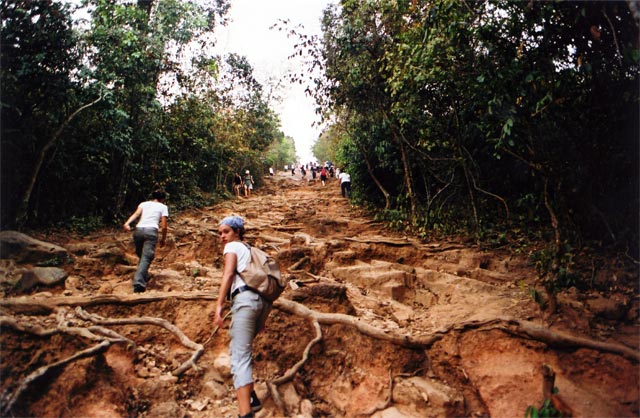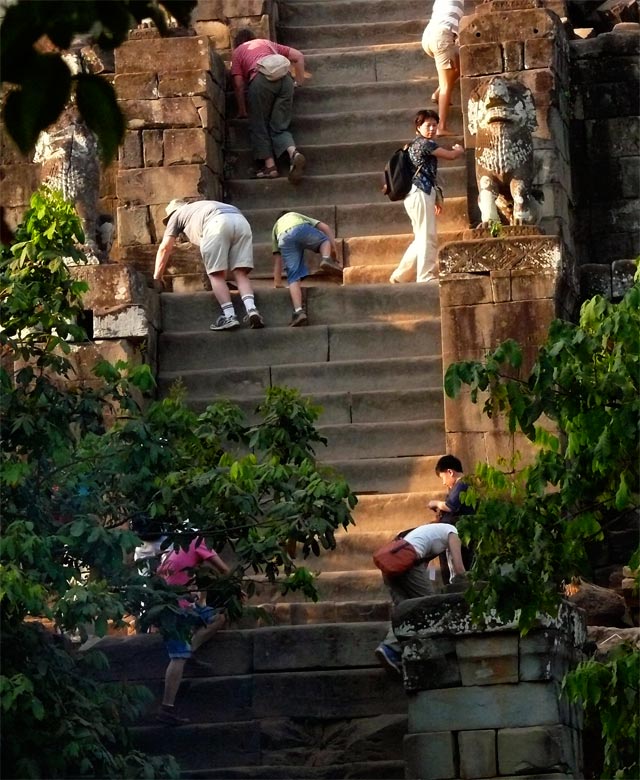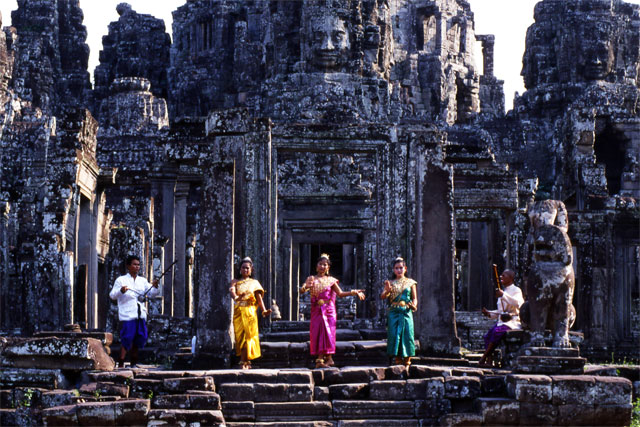Fighting my way through dense vegetation and thorny tangles in a suffocating primordial hothouse, I found a breach into the mythical temple city of Angkor. The oldest and wealthiest Cambodian capital and the center of the Khmer civilization, Angkor reached its greatest splendor from the ninth to the thirteenth centuries, when it became the fulcrum of a great empire in Southeast Asia. After the Siamese occupation of 1437, it gradually declined and fell into complete ruin, becoming once more the realm of tigers, panthers, serpents and monkeys.
I have often returned to this place, and each time it exercises a greater hold over me. Fantasies and mystery seep out from the temple’s dome, and everything, from the vegetation to the buildings, are sacred and monumental. The mastodonic roots of the fromager, or ceiba pentandra, assail whole buildings, while the trunks of the gibbous ficus penetrate between the walls: the tentacled vegetation crushes all man made objects in its inexorable growth. What adds to the fascination of this place is its centuries old titanic struggle, which has neither winners nor losers, in the jungle’s possessive and threatening embrace, while the half shadow of cavities, once magnificent tunnels but now partly collapsed, both invite and repel.
For a whole historic era, Buddhism and Hinduism peacefully coexisted at Angkor. As the main vehicles of artistic expression, these religions here reached the height of their eloquence. Scraping away the moss covering the stones, we begin to realize the extent of the grandeur achieved eight centuries ago in the majestic Buddhist monastery of Ta Prohm, built at the behest of the god king Jayawarman VII. According to legend, as many as eight arch priest, 2,740 priests and 2,002 assistants officiated in this temple.
The glyphs engraved on the stone relate the local history in an almost gossipy way: for example, we learn that 165,744 candles were used in one of the frequent feasts, while 615 apsara, meaning celestial dancers, performed. Even the treasure kept in the temple’s stone strong-boxes is listed: five tons of cutlery and gold plates, five tons of silver, 35 diamonds, 45,000 pearls and 4,500 precious stones. Its territory included 3,140 villages with a population of around 80,000 peasants.
Dozens of temples and hundreds of minor buildings scattered in an area the size of the island of Elba are eloquent proof of the ingenious engineering techniques of the time. The powerful king Jayawarman VII gave his people prosperity. Agriculture developed thanks to great irrigation works, with canals as wide as rivers, dams and enormous reservoirs, thus allowing rice to be harvested two or three times a year.
Leaving by the main gateway, I am immediately assailed by a swarm of young boys selling cool drinks, fake antique objects, mini crossbows, kapei, single cord guitars and other souvenirs. But just then an air-conditioned minibus transporting Japanese tourists arrives, and the whole noisy little crowd immediately takes off in another direction.
Until now, very few foreigners have visited these colossal ruins unearthed by the botanist Henry Mouhot in 1861. At the beginning of the century, the French organization, Conservation d’Angkor, began to patiently free the most important buildings from the undergrowth and attempted to restore them. But Cambodia was to be overwhelmed by a number of tragic events. First, the insurrection against French colonization, then the Indo-China War, the holocaust caused by Pol Pot and the Vietnamese occupation made it impossible for the rest of the world to enjoy this wonder. Five kilometers from Angkor at Siem Reap, I decide to rent a motorbike so I can reach some other monuments as quickly as possible. I am reminded of my first visit to the area exactly 20 years earlier: on that occasion, I rode on an elephant’s back, an adventure within the adventure, while on other occasions I used the more modern means of the bicycle. Driving up the mud track, I go past the Ta Keo Crystal Tower, a pyramid shaped stone mausoleum with terraces and steps. I first cross the Siem Reap River and then a bridge over a canal a hundred meters wide; its balustrade is made up of a row of stylish divine statues watching over the Victory Gate, one of the five entrances in the walls which run for twelve kilometers round the citadel of Angkor Thom. Here, reality outstrips the imagination: the sun blazes triumphantly on four megalithic Buddha faces placed at the entrance, thus making the buildings tower up even more austerely, twenty three meters high.
The religious complex is dominated by the formidable mass of Bayon: in a highly original frenzy of buildings, the stones are fused together in a paroxysmal amalgam of architecture, statues and ornamentation, making it unique in its kind. Around the central body stand fifty four towers, each with the four faces of the ubiquitous Buddha. All of these identical statues emanate the same gentle and enigmatic smile expressing the joy of contemplation. A little further forward are carved stone books running along the external gallery. Embroidered with symbols, the iconography relates the myths and the legendary deeds of the Khmer people and with great realism describes the pomp of the court and the life of the common people.
A few steps to the north of Bayon is the famous Elephants Terrace. Three hundred and fifty meters long, it was once the site of public ceremonies. Here, in 1297, King Indrawarman III received the Chinese diplomat Chou Ta Kuan, who stayed in the Khmer realm for seven months.
In his diary of unique historical importance, Chou gave a detailed account of daily life in the realm: “Twice a day the sovereign grants an audience. Accompanied by music, the king appears at one of the gold framed windows holding the holy sword. He beckons to a minister or a functionary to draw near, and then he invites him to sit on a tiger skin and listens to his problems. The king has five wives and it is said that the number of his favorites is from three to five thousand: the best families vie with each other to offer him their daughters in the hope of obtaining privileges.” The chronicle relates that the Empire enjoyed very rich trade: gold from Sumatra and Korea, tin from Malaysia, mercury, fine wood, silk, spices and dyes. Goods were transported on the rivers or carried by men from the lower cast, disdainfully referred to as dogs, bastards, or worms. A sight not to be missed in Cambodia is Angkor Vat, one of the largest religious buildings in the world. Its five sanctuary towers rise up dominating the threefold wall of galleries decorated by realistic low reliefs. Dating from 1113-70, this temple mountain was built to satisfy the ambitions of King Suryavarman II, when his realm was at the height of its expansion, but also on the threshold of decline. Today, it is still a spiritual center, and its towers appear on the Cambodian national flag. Before making any important decisions for the nation, Prince Sihanouk comes to meditate here.
As the afternoon light slowly moves along the low reliefs creating contrasts between the empty and full volumes of the carved stone, I admire the refined craftsmanship of the delightful apsara stone, dressed in clinging garments highlighting the sinuous movements of the body. Languid music and bright colors suddenly catch my attention. I turn to find three splendid real dancers, dressed in silk costumes embroidered with gold and pearl hems. Here, by some strange magic, they sensuously move to the ancient rhythm, just as the apsara did centuries ago when proffering the joys of life to kings.
The next day, recommencing my solitary pilgrimage, I follow tracks never travelled by tourists: for the umpteenth time I find signs of violent destruction caused not only by the passing of time, torrential rains, decay, the lush growth of the vegetation, but also by human vandalism. The blood thirsty Khmers sought to destroy religious symbols. Then others craving for riches continued the devastation, decapitating the Buddha statues and other divinities. Today, despite stricter surveillance, art thieves remorselessly continue their plunder.
In February of 1993, a band of armed men killed three guardians of the Siem Reap restoration workshop and carried off eleven statues worth around a million dollars. The most famous predator of antiquities still remains, however, the French writer and minister of culture in the De Gaulle government, Andre Malraux. In the 1920s, he carried off low reliefs from the Banteay Srei temple.
To visit this place thirty five kilometers from Angkor, I was advised to take an armed escort. Inspecting the site, I discover that two of the four monkey and monster statues watching over the sanctuary have lost their heads, whereas I remembered them as being intact. What saddened me most, however, were some red signs warning about the presence of mines outside the enclosure left by mindless guerrillas. Recently, Unesco has launched a worldwide appeal to save Angkor. Immense sums of money will be required to do the extensive conservation work for buildings, whose plight is ignored by most. The monuments are in a disastrous and desperate state and the damage may be irreparable.
Many of them are irremediably decayed and often the sand stone crumbles on touch, and so Angkor will never be restored to its original splendor – a precious jewel in a green treasure box.
The forest has not only swallowed up its cathedrals, but it has also defended them.
Thus, perhaps it would be better simply to follow a first aid conservation program to halt the explosive advance of the vegetation and leave everything as it is in the awe-inspiring setting of the silent and dramatic struggle between a world of stone and the power of nature.












